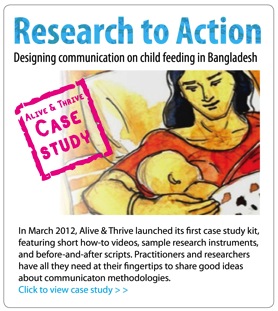Packaging our Field Experience So It’s Irresistible
Instigating behavior change is something we all struggle with in the fight against NCDs. In this guest post, Ann describes how she put her experience as behavior change specialist at Alive & Thrive to good use to develop both a message and delivery that would resonate with her audience and generate action. For more information, see “Research to Action,” Alive & Thrive’s first case study kit. You can follow Ann on Twitter @AnnJimerson.
 While working on a U.S.-based project on obesity, I’d had a gratifying experience with concept testing. It confirmed what I’d thought for a long time – that concept testing, or trying a variety of concepts or message approaches with real audience members, can help you hone in on messages that really resonate.
While working on a U.S.-based project on obesity, I’d had a gratifying experience with concept testing. It confirmed what I’d thought for a long time – that concept testing, or trying a variety of concepts or message approaches with real audience members, can help you hone in on messages that really resonate.
I wanted to share my excitement and convince others that concept testing could work for them, too.
So, I put together a PowerPoint for practitioners like myself, in the business of behavior change.
Despite a warm reception from my colleagues at a lunchtime presentation, a couple of eager 20-somethings were having trouble keeping their eyes open for the full 40 minutes. I tried again in one of our field offices overseas, but it didn’t really make sense to them because the whole project, focusing on obesity, was so very American. And even with a select, receptive audience (okay, I guess people closer to my demographic could sit through it…), my beautifully animated PowerPoint didn’t work without me there to deliver the story. I had a product, but I had to work pretty hard to sell it.
What I needed was a product that pretty much sells itself.
I needed a new case study on concept testing: one that featured an experience outside the U.S., and one that people could use and navigate on their own time and at their own pace. I turned to a 20-something on our project, one who had been teaching herself the basics of video editing, is not intimidated by online mechanics, has a great sense of design, and “gets it” when it comes to behavior change.
Fortunately, our staff in Bangladesh liked the idea of concept testing, and with a little coaching by e-mail, had tried a version of it themselves. They were sold on concept testing as a way to focus their messaging before they dove into script writing for TV spots. Now we had a non-U.S.-based story to share.
To get ourselves out of our public health rut, the 20-something staff member and I shut the office door and surfed YouTube. We had a sweeping story that we wanted to tell succinctly. We typed in “movie trailers.” Voila: Gone with the Wind, the whole epic story summed up in 2½ minutes. We knocked ourselves out with a funny “how to” video on making a poster, and a complex lecture by Dan Pink, amusingly illustrated with text and cartoons, drawn as we watched.
Inspired, we started writing scripts for our own short “how to” videos and cobbled together some mock-ups, using the visuals and software we had at hand.
With no budget beyond our labor, we built a prototype web site with 3 short videos and took it out for a road test. We sat with a few colleagues and asked them to open the Beta version. One reviewer reminded us that a popular book on Web design is titled “Don’t make me think.” We reworked the page to make its purpose clear. We learned a lot about how to make our content shorter – and even shorter. We watched as people puzzled over what the site offered them – then taught ourselves to write explicit, brief text to tell them how they could put the tools to use. We learned that busy practitioners would delight in a sample script or research instrument. They told us they would download it and tuck it away for a training or technical assistance opportunity.
We launched in late March 2012. Already we’ve seen an uptick in visits to Alive & Thrive’s Web site. During the 3 weeks after launch, the rate of people visiting the A&T site was almost double the rate of visitors in several recent months. We’ve gotten practitioners’ attention. One official cited the case study kit as the reason she thought to invite our Bangladesh country director to present at a regional conference.
Right now we’re deep into scripting our second kit: this one on engaging fathers in infant and young child feeding. And building on what we’ve learned, this time the videos will be 2 to 3 minutes, not 4 to 5.
Technology makes glitz easy. But it takes more than glitz. Thinking like a marketer has taken us a bit closer to building a product that “pretty much sells itself.”
Ann can be reached at ajimerson@fhi360.org.
